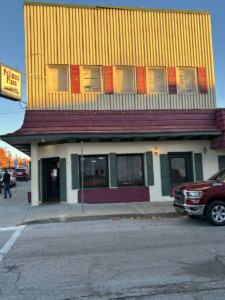November is always a hectic month for me. This month I attended three shows on the first three weekends of the month and the Tulsa Flea Market on the Saturday after Thanksgiving. I last attended the Overlooked Military Show in Leavenworth, Kansas. This show is different from most shows as it is a two-day show. Set-up is Friday afternoon, and the show is finished at three o’clock on Saturday afternoon. This is a new show format, and it has a couple of advantages over the traditional three-day show. In the internet age, people are busy. It is difficult for a show promoter to keep all of the vendors for that slow Sunday when everyone has so much to do. The two-day venue also creates a sense of urgency in the buying public and there is less time to think about what to buy. For those of you who have never been to Leavenworth, KS it is well worth the 185-mile trip. Make sure to make time to visit Fort Leavenworth and visit the Museum and National Cemetery.


Left Image: The show is held in the old Train Station that has been converted into a multi-use facility and sits in front of the still-used train track just behind this building. A little further away flows the Missouri River. Congress instructed Colonel Henry Leavenworth to build the fort on the Missouri side of the river. When he arrived at the site, he ignored their advice and located the post on the high ground on the Kansas side. In the 1820’s this was the frontier. A military road was built to connect Fort Leavenworth to Fort Scott to support law and order by separating the settlers from the Indians. Right Image: The show is sponsored by Jason Claire who also owns the Overlooked Military & Antique shop in downtown Leavenworth.


Left Image: The show was supported by the Leavenworth High School Junior ROTC Color Guard and Rifle Team. The Cadets ran a shooting range and the Concessions Booth that provided food and drink for the show. All profits were used to support Cadet activities. Right Image: A photo of some of the 120 tables of Militaria in the show. Most of the sellers are also collectors and offered a nice selection of items.

Image: A couple of blocks from the show is the Pullman Place Restaurant. The Pullman features a railway station motif. When I was stationed in Leavenworth at the Command and Staff College my staff group would routinely meet at the Pullman where we discussed our lesson over breakfast
Military Memorabilia Finds: German Army Jacket WWII
I was able to pick up a couple of nice items. First was a WWII German Model 1944 short jacket. This jacket was introduced in September 1944 as an economy model and is very similar to the WWII British Battle Dress Uniform.


Left Image: This one has a very nice Field Grey color some of the later ones have more of a brown tint. It had been poorly restored with incorrect insignia. When I got it home I took off the insignia and am working on taking off the glue that attached the breast eagle. Right Image: This is an early model jacket with an interior lining made from the same bolt of material. Later examples often have linings of different types of material that were left over from previous uniform construction. The Germans had acute shortages of most textiles and went to great lengths to find substitute materials.
Military Memorabilia Finds: WW2 Holster – P38 Holster
I also purchased a late-war P-38 black leather holster. The earlier model holster was made from a thicker piece of leather and was molded. This soft-shell holster was another economical solution to save resources.



Left Image: It is made from pigskin leather. Many field gear items were made from this type of leather. Middle Image: The back of the holster is marked for the pistol it was designed to fit. It has two belt loops that allow it to be carried on the black leather equipment belt. Right Image: Most are marked with a three-letter code that identifies the company that produced it. It is also marked with a Waffenamt or an armed forces acceptance stamp. The stamp is marked with an eagle and the letters WaA followed by a three-digit number that identifies the team of inspectors that worked a geographical area.
